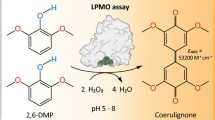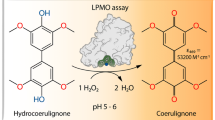Abstract
A rapid method for quantitation of lytic polysaccharide monooxygenase (LPMO) in multienzyme cocktails produced by mutant strains of filamentous fungi is developed. In this method, 2,6-dimethoxyphenol and hydrogen peroxide are used as cosubstrates in a nonspecific LPMO-catalyzed reaction leading to the formation of a colored product. With this method, we determine the LPMO content in the multienzyme cocktails produced by Penicillium verruculosum recombinant strains that homologously express LPMO. The results agree closely with the findings obtained using a method based on the fine chromatographic fractionation of the cocktails followed by the qualitative and quantitative evaluation of their content by electrophoresis and mass-spectrometry and protein quantitation assays in fractions collected from chromatographic separation.




Similar content being viewed by others
REFERENCES
Tiunova, N.A. and Kretovich, V.L., in Tsellyulazy mikroorganizmov (Cellulases of Microorganisms), Moscow: Nauka, 1981, p. 40.
Kirk-Othmer Encyclopedia of Chemical Technology, New York: Wiley, 2001, vol. 13, p. 866.
Sinitsyn, A.P., Gusakov, A.V., and Chernoglazov, V.M., in Biokonversiya lignotsellyuloznykh materialov (Bioconversion of Lignocellulosic Materials), Moscow: Mosk. Gos. Univ., 1995.
Cherry, J.R. and Fidantsef, A.L., Curr. Opin. Biotechnol., 2003, vol. 14, p. 438.
Gusakov, A.V., Trends Biotechnol., 2011, vol. 29, p. 419.
Gusakov, A.V. and Sinitsyn, A.P., Biofuels, 2012, vol. 3, no. 4, p. 463.
Vaaje-Kolstad, G., Westereng, B., Horn, S.J., Liu, Z., Zhai, H., Sørlie, M., and Eijsink, V.G.H., Science, 2010, vol. 330, p. 219.
Zifcalkova, L. and Baldrian, P., Fungal Ecol., 2012, no. 5, p. 481.
Kumar, G.S. and Murthy, D., Biotechnol. Biofuels, 2013, vol. 6, p. 63.
Horn, S.J., Vaaje-Kolstad, G., Westereng, B., and Eijsink, V.G.H., Biotechnol. Biofuels, 2012, vol. 5, p. 45.
Westereng, B., Ishida, T., Vaaje-Kolstad, G., Wu, M., Eijsink, V.G.H., Igarashi, K., Samejima, M., Stahlberg, J., Horn, S.J., and Sandgren, M., PLoS One, 2011, no. 6, E27807.
Westereng, B., Agger, J.W., Horn, S.J., Vaaje-Kolstad, G., Aachmann, F.L., Stenstrøm, Y.H., and Eijsink, V.G.H., J. Chromatogr. A, 2013, no. 1271, p. 144.
Bey, M., Zhou, S., Poidevin, L., Henrissat, B., Coutinho, P.M., Berrin, J.-G., and Sigoillota, J.-C., Appl. Environ. Microbiol., 2013, vol. 79, p. 488.
Bissaro, B., Rohr, A.K., Muller, G., Chylenski, P., Skaugen, M., Forsberg, Z., Horn, S.J., Vaaje-Kolstad, G., and Eijsink, V.G.H., Nat. Chem. Biol., 2017, vol. 13, p. 1123.
Breslmayr, E., Hanzek, M., Hanrahan, A., Leitner, C., Kittl, R., Santek, B., Oostenbrink, C., and Ludwig, R., Biotechnol. Biofuels, 2018, vol. 11, p. 79.
Semenova, M.V., Gusakov, A.V., Volkov, P.V., Matys, V.Y., Nemashkalov, V.A., Telitsin, V.D., Rozhkova, A.M., and Sinitsyn, A.P., Mol. Biol. Rep., 2019, vol. 46, no. 2, p. 2363.
Peterson, G.L., Anal. Biochem., 1979, vol. 100, p. 201.
Cannella, D. and Jørgensen, H., Biotechnol. Bioeng., 2014, vol. 111, p. 59.
Sinitsyn, A.P., Osipov, D.O., Rozhkova, A.M., Bushina, E.V., Dotsenko, G.S., Sinitsyna, O.A., Kondrat’eva, E.G., Zorov, I.N., Okunev, O.N., Nemashkalov, V.A., Matys, V.Y., and Koshelev, A.V., Appl. Biochem. Microbiol., 2014, vol. 50, no. 8, p. 761.
Funding
The study was supported within the research program “Molecular Design, Structure–Function Analysis and Regulation of Enzyme Systems, Cellular Constructs, and Bionanomaterials: Fundamentals and Application in Technology, Medicine, and Environmental Protection” (state registration no. АААА-А16-116052010081-5).
Author information
Authors and Affiliations
Corresponding author
Ethics declarations
CONFLICT OF INTEREST
The authors declare that they have no conflict of interest.
SUPPLEMENTARY INFORMATION
No supplementary information is provided.
Additional information
Translated by A. Kukharuk
Abbreviations: LPMO, lytic polysaccharide monooxygenase; EC, enzyme cocktail; 2,6-DMP, 2,6-dimethoxyphenol; CBH, cellobiohydrolase.
About this article
Cite this article
Telitsin, V.D., Semenova, M.V., Osipov, D.O. et al. 2,6-Dimethoxyphenol-Based Assay for Quantitation of Polysaccharide Monooxygenase in Multienzyme Cocktails. Moscow Univ. Chem. Bull. 75, 96–100 (2020). https://doi.org/10.3103/S0027131420020157
Received:
Revised:
Accepted:
Published:
Issue Date:
DOI: https://doi.org/10.3103/S0027131420020157




